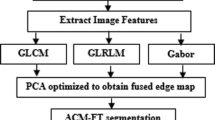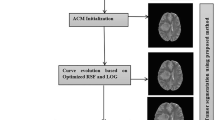Abstract
The three-dimensional models of brain tumors serve as diagnostic assistance for physicians, surgeons, and radiologists. The proposed system establishes an accurate 3D model of the skull vault and overcomes the limitations in the traditional tumors localization methods reported in previous studies. The three-dimensional Gradient Vector Flow (GVF) System recommended in this study uses Magnetic Resonance Images (MRI) and Computed Tomography (CT) as input. It detects the contour of the tumor and the skull region in different slices. Thus, the system constructs a 3D model of the tumor and the skull surface and excludes other tissues. The accuracy of the reconstructed 3D model depends on the accuracy of the tumor contour detection since GVFS plays a significant role in confirming the results obtained without any data loss. Various experiments are conducted to evaluate its accuracy in contour detection and compared the results with those traditional contour detection methods. The recorded results demonstrate that the GVFS method has the highest accuracy in contour detection. Though identifying the suspected region depends on the observer, the outcome is optimistic and unbiased in GVFS. The 2D model can easily be converted into 3D by triggering the elasticity which is already present in GVFS. Hence the proposed method employs direct reconstruction rather than using two different approaches to produce segmentation and reconstruction.



















Similar content being viewed by others
References
Aloui K, Naceur MS (2009) 3D Brain tumor segmentation using level-sets method and meshes simplification from volumetric MR images. World Acad Sci Eng Technol, 33:127
Amrutal A, Gole A, Karunakar Y (2010) A systematic algorithm for 3-D reconstruction of MRI based brain tumors using morphological operators and bicubic interpolation. In: 2nd International conference on computer technology and development (ICCTD), pp 305–309
Bharathi AS, Manimegalai D (2015) 3D Digital reconstruction of brain tumor from mri scans using delaunay triangulation and patches. ARPN J Eng Appl Sci 10(20):9227–9232
Bashir H, Hussain F, Yousaf MH (2015) Smart algorithm for 3D reconstruction and segmentation of brain tumor from MRIs using slice selection mechanism. Smart Comput Rev 5(3):429–438
Bharathi AS, Manimegalai D (2015) 3D Digital reconstruction of brain tumor from mri scans using delaunay triangulation and patches. ARPN J Eng Appl Sci 10(20):9227–9232
Cho KR (2004) Detection, a comparative study of 2D and 3D ultrasonography for evaluation of solid breast masses. Eur J Radiol 54:365–370
Corts E (2009) Mathematical morphology based on dynamic structural components for 3D modelling of brain tumor growth. Int J Comput Inf Eng 3(4):235–240
Fukuoka D, Hara T, Fujita H (2006) Detection, characterization and visualization of breast cancer using 3D ultrasound images, recent advances in breast imaging, mammography and computer aided diagnosis of breast cancer. In: SPIE, Bellingham, pp 557–567
Haider W, Sharif M, Raza M (2011) Achieving accuracy in early stage tumor identification systems based on image segmentation and 3D structure analysis. Comput Eng Intell Syst 2(6):96–102
Kadir A, Zarina WE (2010) Comparison of balloon snake and GVF snake in segmenting masses from breast ultrasound images. In: Proc Symp Second international conference on computer research and development. IEEE, pp 505–509
Karkavelas G, Tascos N (2002) Epidemiology, histologic classification and clinical course of brain tumors. In: Imaging of brain tumors with histological correlations. Springer, Heidelberg, pp 1–2
Kass M, Wikkn A, Terzopoutos D (1986) Snakes: active contour models. Int J Comput Vis 3:321–331
Khotanlou H, Colliot O, Atif J, Bloch I (2009) 3D Brain tumor segmentation in MRI using fuzzy classification, symmetry analysis and spatially constrained deformable models. Fuzzy Sets Syst 160(10):1457–1473
Kistler M (2013) The virtual skeleton database: an open access repository for biomedical research and collaboration. J Med Internet Res 15(11)
McInerney T, Terzopoulos D (1996) Deformable models in medical image analysis: a survey. Med Image Anal 1:91–108
Menze BH, Jakab A (2014) The multimodal brain tumor image segmentation benchmark (BRATS). IEEE Trans Med Imaging. https://doi.org/10.1109/TMI.2014.2377694
Mojsilovic A, Rogowitz B, Gomes J, Deisboeck TS (2002) Analysis and 3D reconstruction of heterogeneity in malignant brain tumors: an interdisciplinary case study using a novel computational visualization approach. Anal Quant Cytol Histol 24(3):125–133
Nabizadeh N, Kubat M (2015) Brain tumors detection and segmentation in MRI images: gabor wavelet vs statistical features. Comput Electron Eng 45:286–301. Springer
Popuri K, Cobzas D, Murtha A, Jägersand M (2012) 3D Variational brain tumor segmentation using Dirichlet priors on a clustered feature set. Int J Comput Assist Radiol Surg 7(4):493–506
Scholl I (2011) Challenges of medical image processing. Comput Sci Res Dev 26:5–13
Siddiqi AA, Khawaja A, Tariq M (2011) 3D volume representation of brain tumor using image processing. In: IEEE International conference on signal and image processing applications (ICSIPA), pp 72–75
Siddiqi AA, Khawaja A, Tariq M (2012) 3D Representation of human skull bearing the tumor using image processing. In: Fourth international conference on computational intelligence, communication systems and networks (CICSN), pp 257–260
Smolic A, Kauff P, Hnorr S, Hournung A, Kunter M, Muller M, Lang M (2011) Three dimensional video postproduction and processing. Proc IEEE 99(4):607–625
Suri J, Guo Y, Coad C, Danielson T, Elbakri I, Janer R (2005) Image quality assessment via segmentation of breast lesion in xray and ultrasound phantom images from FFDMUS system. Technol Cancer Res Treatment 4(1):83–92
Tabrizi JH (2003) Using active contour for segmentation of middle ear images. McGill University, Qubee
Xu C (2009) Gradient vector flow deformable models. In: Handbook of medical image processing and analysis. Imprint of Elsevier, 2nd edn, pp 181–189
Xu C, Pham D, Prince J (2000) Image segmentation using deformable models. Handb Med Imaging SPIE 2:129–174
Xu C, Prince JL (1997) Gradient vector flow: a new external force for snakes. In: Proceedings of the IEEE conference on computer vision. IEEE, Baltimore, pp 66–71
Yang X, Yang X (2009) 3D Interpolation of image elastic deformation using delaunay triangulation. IEEE, pp 1–4
Zhou W, Xie Y (2013) Interactive medical image segmentation using snake and multiscale curve editing. Computational and mathematical methods in medicine. https://doi.org/10.1155/2013/325903
Acknowledgements
This work would not have been possible without the guidance support by Dr. A. Srinivasan, Head, Department of Radiology and Radiological Sciences, Thanjavur Medical College, Tamil Nadu. I am especially indebted to Ethical committee members, Dr. S. Jeyakumar., Ms., MCh., DNB., FRCS, Dean, TMC, and Other technical support faculty. The authors also wish to express their sincere thanks to the Research Associate Fellowship (No.09/1095(0048)19-EMR-I), Council of Scientific and Industrial Research (CSIR), India for their financial support.
Author information
Authors and Affiliations
Corresponding author
Additional information
Publisher’s note
Springer Nature remains neutral with regard to jurisdictional claims in published maps and institutional affiliations.
Rights and permissions
About this article
Cite this article
Deepika, M.M., Raajan, N.R. & Srinivasan, A. Three dimensional reconstruction of brain tumor along with space occupying in lesions. Multimed Tools Appl 81, 12701–12724 (2022). https://doi.org/10.1007/s11042-022-12352-x
Received:
Revised:
Accepted:
Published:
Issue Date:
DOI: https://doi.org/10.1007/s11042-022-12352-x




